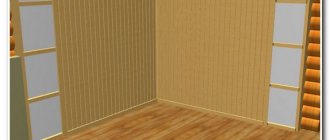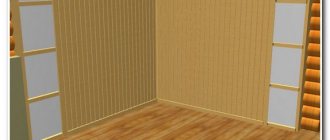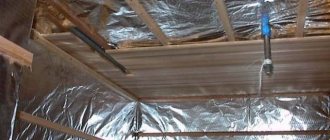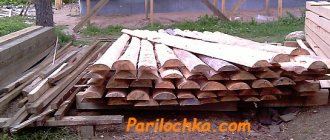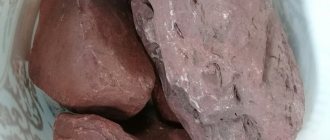Kikimora
17973 2 13
Kikimora November 29, 2016Speciality: I love my home, I like to equip it, periodically change something, do it with my own hands. There are no special hobbies. I am the administrator of a small women's forum.
Traditional Russian bath
If we often leave repairs in the apartment to the shoulders of specialists, for fear of messing up, then decorating a bathhouse with our own hands seems to many not such a serious matter. But is it? The bathhouse consists of several rooms with completely different purposes and requires a serious approach to the selection of materials for each of them. If you are interested in finding out what is the best way to decorate a bathhouse inside and outside, I am ready to share my experience.
How to inexpensively cover the inside of a bathhouse
It will be inexpensive to line the inside of a bathhouse, provided that a person is familiar with the available products. Some of them have significant drawbacks.
To decide how to decorate the inside of a bathhouse cheaply, it is better to look at all the options. Next, the manufacturers that are on the market are evaluated.
Steam room finishing
The finishing of the bathhouse is always carried out according to a similar plan:
- Preparation;
— insulation;
— waterproofing;
— vapor barrier. If you are wondering what is the best way to sheathe the inside of a bathhouse, you should start with one layer. Next, you will be able to decide on waterproofing and vapor barrier. The bathhouse must be protected from the inside; mineral wool alone is not enough.
Bathroom trim
Especially novice builders are curious about how to sheathe a bathhouse in the bathroom area. The following materials are suitable for this:
- tile;
— salt blocks;
- stone.
The bathhouse in the bathroom area must be protected, since the temperature there is high. Fireproof materials differ by class. Wall covering is done in layers, since wool or tiles perform a certain amount of work.
Salt blocks may seem like a strange material to some, but they are becoming increasingly popular in the construction industry. Beginning masters have a desire to learn more about them. Blocks are available in different types:
— 200 by 100 mm;
- 200 by 200 mm.
Among the features is high strength. Salt blocks are easy to process, so you can use a grinder. The unique appearance is taken into account since they have a transparent structure.
You can create a unique atmosphere in the bathhouse. Together with the salt blocks, it will look like an ice castle. The environmental friendliness of the blocks is another plus. Builders understand that the elements can be laid on a concrete surface without any problems.
Additional features:
— durability;
— ease of cleaning;
- resistance to high temperatures.
Salt blocks can be purchased immediately in large quantities. For one product they ask from 250 rubles.
View this post on Instagram
Post from Rinat Salimullin (@rinat_spa)
Arrangement of the rest room
Pressing issues during the construction of a bath include what to decorate the walls with and how to arrange it. Shelves can be arranged in one or several rows. People think about cabinets and a small table.
Experts give their recommendations:
— the walls in the bathhouse should be multi-layered;
— folding structures are used;
- shelves can only be made of wood.
This means that the interior decoration must meet the standards. When construction begins, it is advisable to remember the standards, because depending on the quadrature, the humidity and maximum temperature changes. Bathhouse lining can be inexpensive when the above parameters are calculated.
Which insulation is better depending on the type of building
When choosing insulation for the walls of a bathhouse, it is important to consider what material it is built from.
From timber
In the case of a durable type of wood and a relatively large cross-section of each element of the frame, it is enough to simply caulk the cracks and treat the walls with impregnations against fungus and mold, as well as compounds that protect against moisture and fire.
In other situations, all rooms (especially the steam room) must be insulated with basalt wool - in one layer, using the “Pie” technology (we will consider it separately below), additionally laying foil material to minimize the harmful effects of steam.
Made of brick
It freezes quickly in the cold season. This means that measures need to be taken to ensure that a suitable microclimate inside is maintained even in the harshest winter. To do this you can:
- install second walls around the entire perimeter;
- or make a double thermal insulation layer.
To create the sheathing, it is better to use wood rather than metal, since the latter gets very hot during operation. Naturally, it is recommended to treat the prepared structure with agents against fire, rotting, and insects.
Made from concrete
In this case, you can insulate the walls in the steam room of the bathhouse from the inside and outside. Such a serious approach will result in the absence of problems with the masonry getting wet (due to condensed steam), and will become a measure that effectively prevents rapid destruction.
Here the craftsman upholsters the surfaces in the room with 10 cm thick mineral wool (or an analogue suitable in structure), and from the street he arranges a hinged ventilated facade, that is, he fixes the same basalt sheets and covers them with clapboard or siding. The method is relatively expensive, but it guarantees the correct microclimate.
Made from expanded clay concrete blocks
Here you will also need moisture-resistant material, but in combination with high-quality hydro- and vapor barrier. Plus, it is worth installing additional ventilation - this will help level out the increased level of humidity. It is quite acceptable to lay foil tape in as thin a layer as possible.
Operating conditions
To cover a steam room, it is important to remember the operating conditions. When contacting surfaces, fire safety standards are observed. As you know, a person can get burned. Installation standards for the bathhouse are met. The materials are securely fixed and, even with high humidity, remain in place and do not expand much. In the sauna you should definitely put signs on things that are prohibited from touching. Inside, in addition to the lining, other materials can be used. Some of them are specially processed.
Ceiling insulation
It is carried out from top to bottom: it is simply more convenient to carry out work in this way, because it is easier to descend systematically than to take on one surface, skip another, and then return to it. It is this order that makes it possible to ensure the same microclimate at every point of the building - there will be no hot or cold zones. True, for this it is necessary to lay the materials overlapping, so that later it is easier to fasten them together.
Craftsmen thermally insulate the ceiling according to the following scheme:
- cover its surface overlapping with roll materials of your choice;
- the bars are mounted, forming a frame;
- place foil on top, covering all connections;
- glue the joints with aluminum tape (several times), evaluate the tightness;
- carry out installation;
- lined with clapboard finished to look like wood.
Interior decoration of the bathhouse, what is used besides lining
If we consider a Russian bathhouse, the inside is lined with the following materials:
- ceramics;
— block structures;
- wooden panels.
There is always the possibility of replacing the material with another, and combinations are appreciated. So, the upper part can be decorated with panels, and the lower part with blocks.
As you can see, the lining can be replaced with artificial materials. In conditions of high humidity they really show good results. Even new materials such as glass magnesite and salt blocks are suitable for finishing a bath.
It is ceramics that attracts special attention from builders. Peculiarities:
- strength;
— chic appearance;
- environmental friendliness.
When builders choose ceramics, they understand the structure. The blocks contain clay, so they are not afraid of elevated temperatures. They are also not afraid of changes.
If you look at the types, you can find fireclay and majolica. There is a difference in block sizes. Users try to choose an interesting shade so that it looks good in the room.
Additional factors are also taken into account:
— surface smoothness;
— number of layers;
— transparency.
Types such as fireclay and porcelain are the most common.
Alternative finishing materials
It’s interesting what you can use to cover a bathhouse when your budget is very limited. Builders claim that some types of trees are easy to get for next to nothing. Options to choose from:
- Linden;
- birch;
- hemlock.
The dressing room will look great from linden. Don't forget about the unique appearance and pleasant smell. It is inexpensive to make decorations from birch. It is important to choose materials without knots.
That the room looked beautiful, hemlock is suitable. The type of wood became especially widespread in America. Now there is so much of it that a batch for walls in a bathhouse can be obtained at a low price.
If we look at linden in more detail, we can note the following advantages:
— lightness;
- variety of shades;
- high density.
Despite the high density, the material breathes. Builders try to make the sheathing from oak or other wood. The most important thing is to use appropriate insulation that will not affect adjacent layers.
When processing, you should follow standard tips. First, the surface is cleaned. The cut can be made at a slight angle. If you need to grind down the edges, sandpaper will do.
Some people are interested in special grinding machines to work faster. On a construction site, you should always have a good saw on hand. Workpieces usually have to be divided at right angles.
If we consider the features, it is worth highlighting the following:
- low density of cheap varieties;
- limited service life compared to other breeds.
Craftsmen point out that without impregnation, linden behaves unpredictably.
Steam room
Dense types of wood feel comfortable in a wooden steam room. The following are actively offered on the market:
- Linden;
- aspen;
- alder.
The first option is definitely inexpensive. It will be possible to take it with a reserve, but the entire batch is checked. A cheap sheet may initially have traces of mechanical damage.
Aspen is definitely suitable if you immediately consider all the advantages:
- environmental friendliness;
- subtle smell;
- resistance to moisture.
Some people like the fact that aspen, with proper dexterity, bends. Thus, it is possible to design interesting transitions. Some people get creative with the process and work on arches.
Aspen can be used with other species, the main thing is to watch the joints. Another point is ease of use. If you look at the surface, it rarely gets dirty. Various impregnations can be used for processing.
Washing
The beautiful appearance of a bath depends on the washing room, among other things. Popular offers:
- croaker;
- Linden;
- spruce.
If you cover the sink with a slab, you should be prepared for a long installation. It should be recognized that some breeds are not very easy to process. The wall will turn out beautiful if you use special protective equipment, and it is important to remember about the adhesive base.
Linden is definitely suitable for construction, if you take into account a number of features:
— lightness;
— porosity;
- color change.
Thus, linden is suitable for indoor use, but you should be prepared for the surface to change color over time. Some consider this a significant drawback. Others see their advantages in darkened wood.
The most important thing is that linden can be processed with ordinary tools. Even if you take a large file, the teeth will not tear the fibers. At the same time, you will have to make efforts to achieve effective work.
If it is important to make the cut at a slight angle, it is better to use a device. This way you can fix the board.
Restroom
A properly decorated rest room is pleasing to the eye. It all starts with the material, and here the following options are good:
- alder;
- Linden;
- spruce.
As always, the material must meet the standards. Blanks must be checked manually; dimensions are important. Wooden wood with a lot of chips can be immediately put aside.
The most interesting thing is that the above wood species are similar in many ways. However, when finishing the rest room according to the instructions, it is worth considering the type of the final result.
How and with what materials to decorate the pros and cons of natural and artificial
If a sauna or bath is considered, the most worthy materials are considered to be the following:
— lining;
- tile;
- stone.
Many people have a desire to use natural materials. The following advantages are noted:
- environmental friendliness;
- nice smell.
Minuses:
- scarce types of lining;
- a large percentage of defects.
There is a need to cover the bathhouse with artificial materials, it is also important to remember the advantages:
- high quality;
- durability.
Minuses:
- not a pleasant smell;
- cheap look.
Thus, natural and artificial options have many advantages and disadvantages.
Features of wood cladding
I wonder how to line the inside of a bathhouse cheaply. Wood comes first, but it has a number of features:
- many types;
- inexpensive fasteners are suitable;
- Possibility of using glue.
Finishing the inside of a bathhouse using wood assumes that the master is familiar with the material. It is important to know about expansion, mechanical properties. Practice shows that lining the inside of a bathhouse can take longer if the percentage for defects is not calculated.
Many people are interested in how to line a bathhouse from the inside in order to spend a minimum of time on work. In terms of ease of processing, coniferous species are valued.
View this post on Instagram
Publication from Sib-Stroi-Comfort (@sib_stroi_komfort)
Steam room materials
The internal appearance of the bathhouse largely depends on the steam room. It is worth evaluating all the options, but the following are in greatest demand:
- Finnish spruce;
- pine;
- beech.
The steam room must be prepared and a film is laid in front of the main layers. Alder, aspen and beech are suitable as the main insulation. You can additionally consider cedar, but it is now rising in price.
Even professionals are interested in how to line a bathhouse in order to save as much as possible. In this regard, linden comes first.
If we look at pine in more detail, it has the following features:
- strength;
— durability;
- heat retention.
In terms of moisture, the indicators are at the level of oak. Impregnated material will last about 10 years. Over time, pine does not lose color. As for the smell, it changes.
Characteristics:
— bending up to 80 MPa;
— density 450 kg per cubic meter.
Pine has average compression performance. The fibers hold up well during sudden temperature changes. If you take a board, the tensile strength is 90 MPa.
Builders are familiar with the need to handle clapboard carefully. If workpieces of small thickness are used, there is a high probability of chipping. For example, you need to divide the lining, and for this it makes sense to take a file with fine teeth.
View this post on Instagram
Publication from Upholstering SAUNA IN KAZAN (@kluchksaune)
Washing material
If you are curious about how to line the inside of a bathhouse, the following is considered for the washing room:
- fake diamond;
- pine panels;
- hemlock.
If the steam room is easy to cover with thin sheets of aspen, then you can approach the washing room in an original way. PVC panels and even ceramics are valued. It’s interesting how to line the inside of a bathhouse in addition to the above methods. Here, planken acts as an alternative.
Material for the rest room
I'm always curious about how to line the inside of a bathhouse cheaply and beautifully. For the rest room, the following methods come first:
- brick;
— lining;
- siding.
The inside of the bathhouse is decorated in the same style. For example, lining and brick practically do not go together. If you take siding, PVC panels will do. When considering a bathhouse, the finishing must be calculated in advance.
Lining does not require a large percentage of inventory. Some are interested in how to line the inside of a bathhouse so as not to attract help. It is easier to choose a brick from the above methods.
Next, we take into account what the craftsman uses to line the inside of the bathhouse. First on the list is lining of different types.
The process of covering walls with clapboard step-by-step instructions
If previously the question of how to line the inside of the dressing room inexpensively was of interest, now it’s worth considering the process itself.
Instructions:
- Preparation;
- the basis;
- covering the inside of the bathhouse with the first layer;
- isolation.
Wall cladding in a bathhouse begins with preparation, since the surface must be cleaned.
View this post on Instagram
Publication from Rinat Salimullin (@rinat_spa)
“Pie” insulation technology
It is called so because, upon completion of the work, the wall is covered with several layers at once: thermal insulation, vapor barrier, cladding. You should start from top to bottom.
First of all, attach the bars to the load-bearing surfaces - at a distance from each other 1 cm less than the width of the mineral wool. Having created the frame in this way, you mount basalt slabs on it by surprise - carefully, without crushing the edge, ensuring a tight fit. Do not forget that gaps are places where moisture accumulates and “cold bridges” form.
Cover the resulting structure with a vapor barrier, so that its foil side faces the inside of the room, and be sure to seal all joints and seams with special tape. Then you perform the sheathing - directly on the wood of the still protruding base, at a distance of 5-10 cm from the previous layer. This way you will create a buffer zone in which the condensate will drain without coming into contact with the lining and without subjecting it to rot. And to finish, close the “Pie” with the lining.
What not to insulate and sheath a steam room
Many people wonder what can be used to line the inside of a bathhouse. However, it is equally important to consider what not to use.
Methods:
- foam;
- plastic;
- PVC films.
It is easy to line the inside of a bathhouse with plastic, but this material is not suitable. Films can only be used as intermediate options. When asked how to decorate the inside of a bathhouse cheaply, it is worth talking about different methods, but avoid flammable objects.
Some are curious to learn more about PVC film. As the temperature rises, this finish in the bathhouse will change. Since the layers are bonded, the entire insulation is affected.
When deciding what to cover the inside of the bathhouse with, other than lining, it is worth remembering safety. Natural objects without impregnation pose a danger indoors.
How to make a partition in a brick bath?
From the first lines it is worth agreeing that partitions appear when the bathhouse is remodeled. IN…
Wood, Materials for a bath inside, Materials for finishing a bath, Materials for building a bath, Finishing · 09/18/2019 · 0
Which tree to choose for a bath
Craftsmen are often asked the question of how to line the inside of a bathhouse inexpensively. The following types of wood come to mind:
- alder;
- oak;
- pine.
When you are interested in how to decorate the walls in a bathhouse, it is worth remembering the basic properties. We are talking about strength and moisture resistance. The wooden inner lining of the bathhouse should not lose its properties even at elevated temperatures.
View this post on Instagram
Publication from Rinat Salimullin (@rinat_spa)
Oak
If the question of what is used to line a bathhouse is interesting, it is worth evaluating oak.
Pros:
— interesting structure;
- nice smell;
- Possibility of simplified installation.
When asked how to sheathe the inside of a bathhouse, most often craftsmen talk about the need to clean the surface. First, preparation is carried out and all hangnails are removed.
Thus, the question of how to line a steam room inside a bathhouse is more relevant than ever. The price for oak starts from 20 thousand rubles. per cubic meter.
Linden
Linden is ideal for baths for the following reasons:
- variety of shades;
— ease of processing;
- boards of different sizes.
If you are interested in what is the best way to line the inside of a bathhouse, it is important to immediately evaluate the prices of linden. The 30 by 90 by 1000 mm format remains in demand. On the Internet, you can enter a query about how to line the inside of a bathhouse, and suggestions about linden will quickly appear. One board costs from 100 rubles.
Aspen
Aspen remains in demand for baths due to the following advantages:
- dense structure;
- different formats;
- Possibility of installation yourself.
When people are interested in how to decorate the inside of a bathhouse, aspen often comes to mind. They try to be objective, since for one piece they will have to pay from 150 rubles. If you consider how to decorate a bathhouse, aspen is surprised by its environmental friendliness. Some people choose it because of the smell. This lining for a bathhouse inside can be interesting in combination with other types of wood.
As an option, consider birch or beech. The finishing in the bathhouse is prepared by polishing.
Alder
The first question to the master is how to line the inside of the sauna. Alder is an amazing breed that has the following advantages:
- lovely drawing;
— moisture resistance;
- durability over many years.
Now, when they ask what to decorate the inside of the bathhouse with besides the lining, we can safely say about alder. Options available starting at RUB 150. for the workpiece.
If you search, the interior decoration of baths is available in different formats. If combination options are interesting, beech or pine is considered. Now it’s clear how to decorate the inside of the bathhouse, but it’s important to find a trusted supplier.
Cedar
It’s difficult to immediately figure out what can be used to cover a bathhouse. Cedar itself is not impressive in its properties, but it has the following advantages:
— low conductivity;
— the material breathes;
- not afraid of high temperatures.
The inside of a sauna with cedar looks special.
Larch
If you are interested, the interior decoration of the bathhouse, materials, larch should not be considered the last thing. She has the following advantages:
— good structure;
- smooth surface;
- presence of resins.
When asked what to line the inside of a bathhouse with, it’s worth looking at larch in more detail. Coniferous trees additionally have medicinal properties. If you are interested in the best way to sheathe the inside of a bathhouse, it is better to decide on several options. Larch can be combined with beech or oak.
Pine
The next question is what can be used to line the inside of a bathhouse. Pine is considered an excellent candidate, because the following advantages are noted:
- adheres well to nails;
— does not lose color;
- resistance to moisture.
Such lining of the baths inside attracts attention with its appearance. Pine harmonizes with other types of trees. When asked what can be used to line the inside of a bathhouse inexpensively, it is worth pointing out the combinations - pine and cedar, pine and spruce.
FAQ
I want to cover a timber wall with foil and clapboard on it. Is this finishing option possible?
The advantage of a wooden bath is the ability of the material to independently regulate temperature and humidity. Enter the brick bathhouse, lined with clapboard and wooden. In the latter, the steam is softer and more pleasant. Foil neutralizes these advantages and you end up with something in the form of a thermos.
The larch in the steam room began to spew resin. Can it be removed or does the casing need to be replaced?
No need to change the casing. The resin can be drawn out of the wood and removed. Preheat the bath to maximum temperature. As soon as the room has cooled down, scrape off the released resin with a spatula, then wash the wood with a solution of 25 g of liquid soap and 50 ml of ammonia per 1 liter of water. Repeat the procedure until the discharge stops.
The paneling in the steam room has darkened and the view is somehow not pleasing. Is it possible to return the previous light color?
Treat the walls with chlorine-based bleach, special (Neomid, Sagus) or household. Then run the sauna dry to remove chemicals.
Which tree to choose if you are sensitive to odors?
Poplar. It produces practically no odor when heated, since it does not contain phenols, and is widely used even in baths and saunas for medical purposes.
The choice of wood for the interior decoration of a bathhouse should be deliberate. It is worth considering not only the external, but also the technical characteristics of the material, as well as the microclimate features of a particular room.
